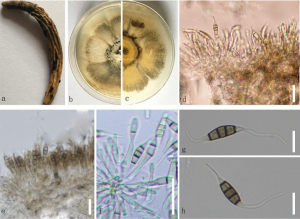Pestalotiopsis bulbophylli S.F. Ran & Yong Wang bis,in Wang, Ran, Maharachchikumbura, Al-Sadi, Hyde, Wang, Wang & Wang, Phytotaxa 306(1): 97 (2017)
Index Fungorum number: IF 820897; MycoBank numbers: MB 820897; Facesoffungi number: FoF 02919
Etymology − In reference to the host genus.
Colonies on PDA reaching 9 cm diam, after 10 days at 25 °C, edge regular, whitish. Reverse same colour. Saprobic on Bulbophyllum thouars. Sexual morph: Undetermined. Asexual morph: Conidiomata pycnidial, globose, solitary, black. Conidiophores 15−35.5 × 2−4.5 μm, cylindrical, hyaline to subhyaline, smooth-walled. Conidiogenous cells holoblastic, simple, integrated, determinate, hyaline. Conidia obovoid to fusiform, straight to slightly curved, with 4 transverse septa, 15−21.5 × 5.5−8 μm (x̄ = 17.5 × 7.0 μm, n = 30), constricted at the septa, smooth-walled; apical cell hyaline, obconic to cylindrical, 2.5−5.5 μm (x̄ = 3.5 μm, n = 30), with a single tubular apical appendage, arising from the apical crest, unbranched, 10.5−22 μm long; basal cell obconic to cylindrical, hyaline, 2.5−6 μm (x̄ = 3.5 μm, n = 30), a basal appendage filiform, unbranched, 5−13 μm long; three median cells doliiform to cylindrical, concolorous, brown, 11−14.5 μm (x̄ = 12 μm, n = 30).
Type − CHINA, Guangxi, Baise city, Yachang Orchid National Nature Reserve, on dead stem of Bulbophyllum thouars, 9 November 2015, Shuang-Fei Ran YC5534 (HGUP 7001, holotype), ex-type living culture GUCC 7001.
GenBank Accession numbers − ITS: KX024706, LSU: KX024707, β-tubulin: KX673486.
Notes − Because of a lack of molecular data originated from representative strains of the most similar species Pestalotiopsis kansensis, we determined the taxonomic placement of P. bulbophylli mainly based on morphological comparisons. Our new species differs from P. kansensis in smaller conidia (15−21.5 × 5.5−8 μm vs. 21−30 × 7−8 μm) and possessing a 5−13 μm long basal appendage (Sutton 1980). For Monochaetia camelliae similar to our strain in morphology, its 4-septate conidia (18−20 × 4−4.5 μm) without constriction at septa were narrower than our strain which has constricted septa (Miles 1926). In addition, its apical appendage is also shorter (12−14 μm long) (Miles 1926) than that of our strain (10.5−22 μm). Pestalotiopsis monochaeta produced obviously larger conidia (27−40 × 7−11 μm) with a longer apical appendage (43−67 μm long) (Maharachchikumbura et al. 2014). The phylogenetic analysis of the combined four gene loci ( ITS, LSU, β-tubulin and tef1) also distinguishes our strain from P. kansensis, P. monochaeta and M. camelliae with a credible bootstrap support (Fig. 2). The morphological comparisons and phylogenetic analysis support our treatment of HGUP 7001 as a new taxon.
FIG 1. Pestalotiopsis bulbophylli (HGUP 7001, holotype). a Host material. b Colony on PDA from above. c. Colony on PDA from below. d−e Vertical section of conidioma. f Conidiophores and conidia. g−h Conidia. Scale bars: d−e = 20 μm, f−h = 10 μm.

